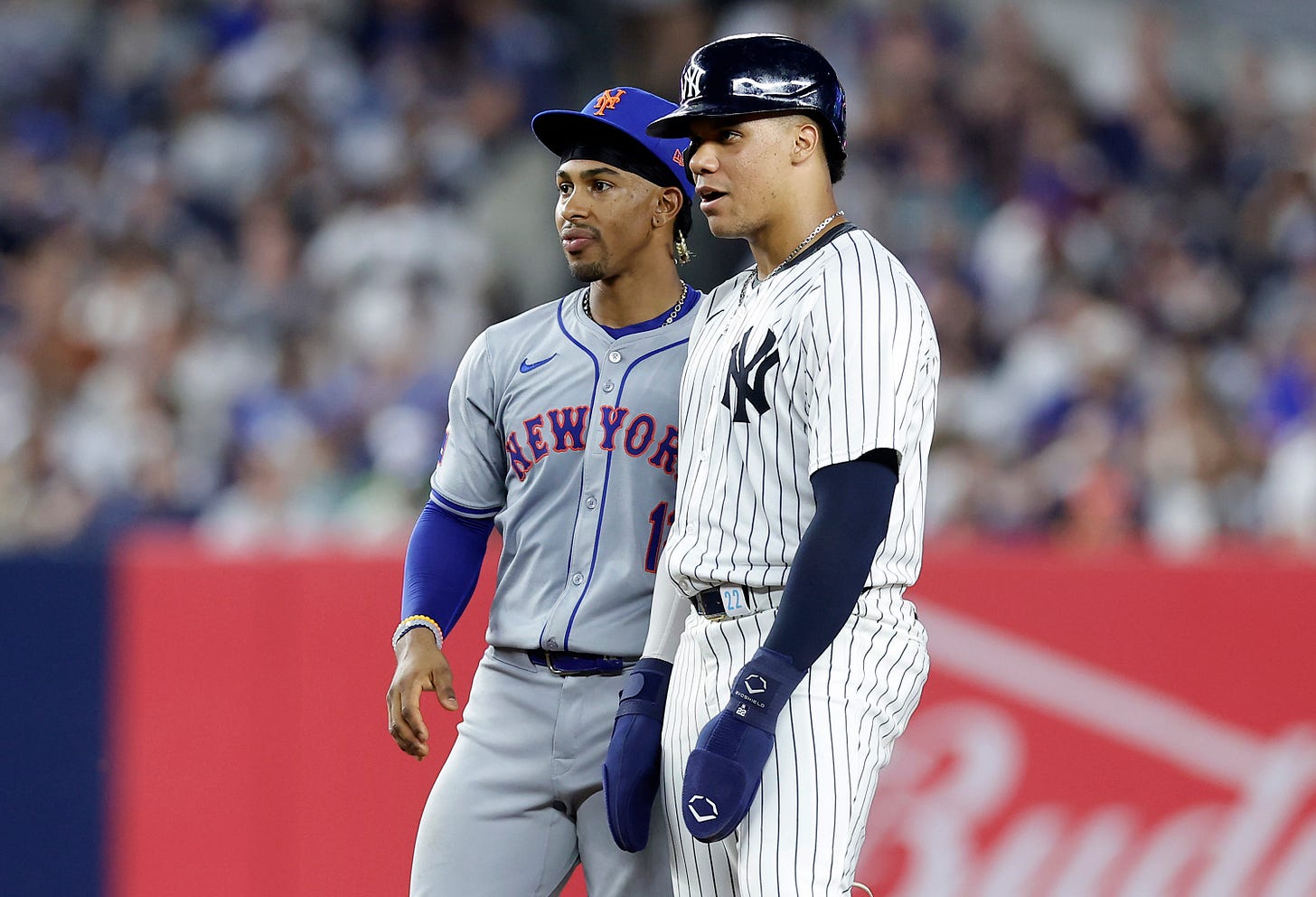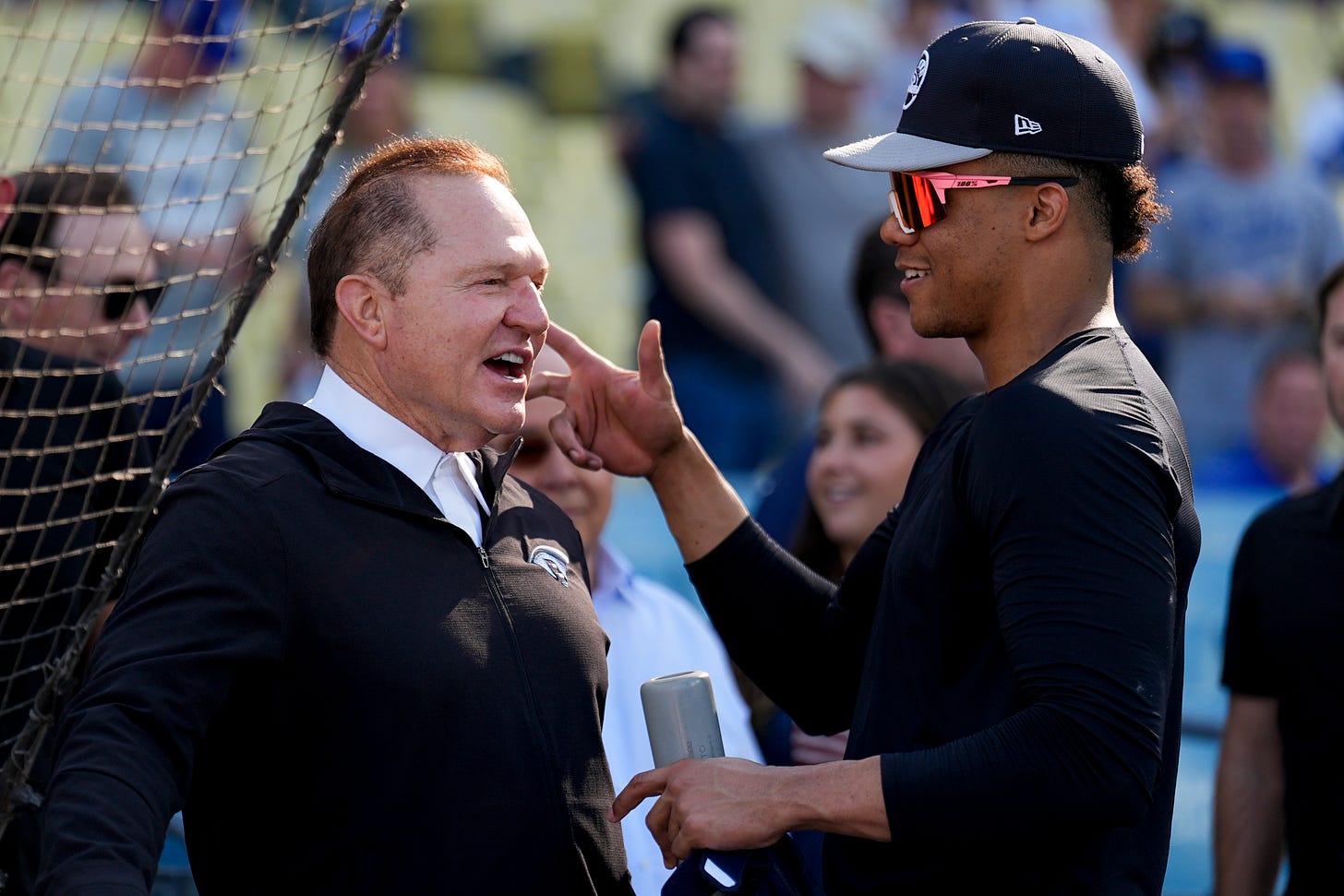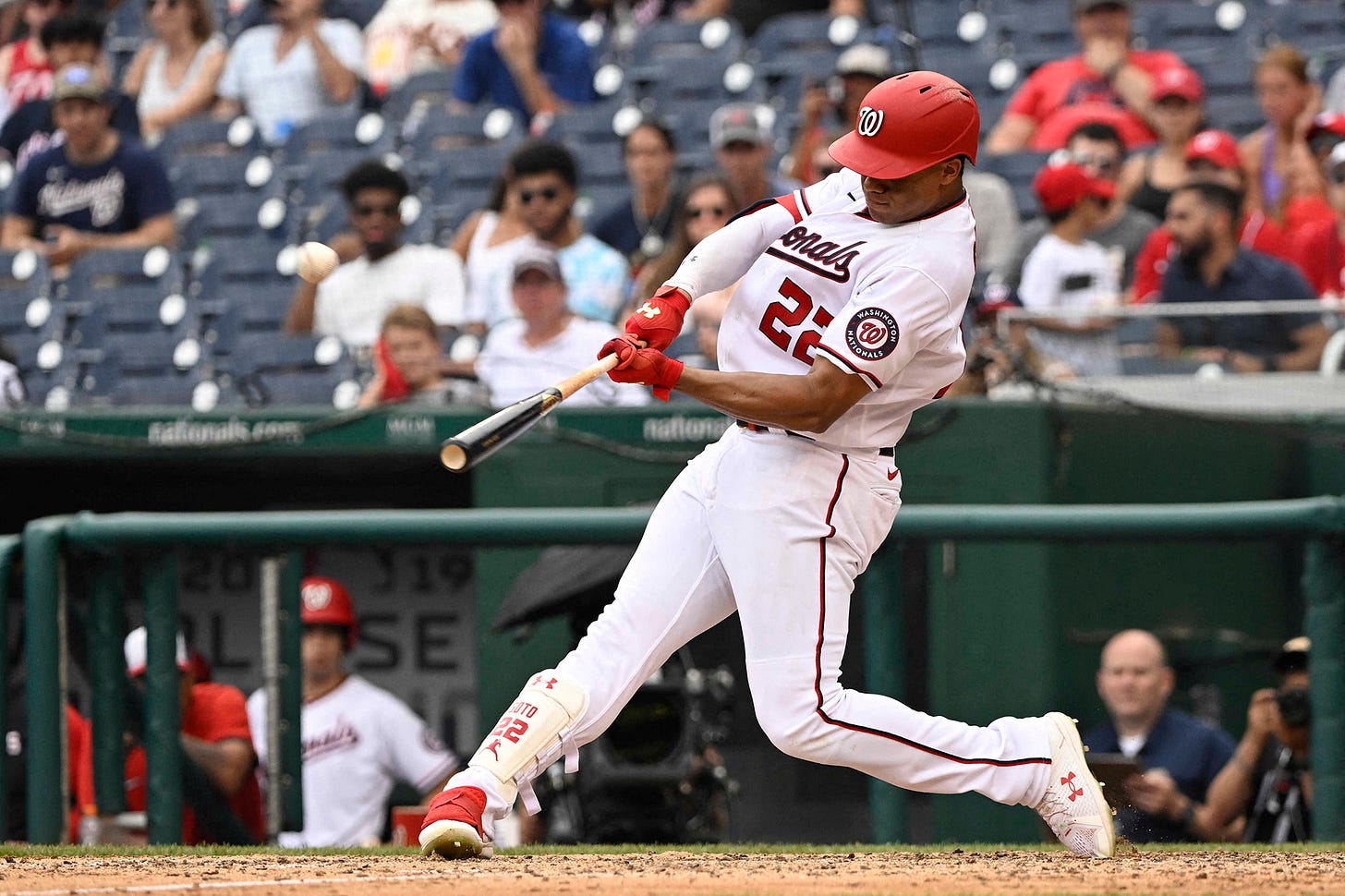Digesting the game-changing impact of Juan Soto's new deal with the Mets
Also - how and why this became a perfect storm for the Mets to land one of the game's best players in free agency
I have had 12 hours to fully digest what has transpired between Juan Soto and the Mets, and wanted to put all of my thoughts, which have been fragmented on social media, into something more thoughtful and articulate.
In short, this is a special time for the Mets. They’ve done something with Soto here that fans could only dream of under the previous owner. They never even would’ve called Scott Boras on Soto, let alone been among the finalists to procure his services for the next two decades.
But this is a different time for the Mets.
They went from having an ownership group under financial duress who had historically made generally conservative investments into their organization to the game’s richest owner who has transformed who and what the Mets are and how they are both run and recognized throughout the industry. They’ve gone from an organization 10 years behind to one that is on the cutting edge with things we can’t see or hear from analytics to biometrics, have attracted stars both on and off the field, and positioned themselves now to be among the game’s elite.
And they just pulled off the most significant free agent acquisition in their history, not to mention a record deal for baseball which creates a new ceiling for future free agents.
So, let’s get into it…
The impact
Last winter, the Dodgers committed around $1 billion on new free agent contracts, thanks in large measure to the deals they gave to Shohei Ohtani and Yoshinobu Yamamoto.
The Mets are now on pace to join the Billion Dollar Free Agency Club during the 2024-2025 off-season.
In a matter of 3 1/2 years, Mets owner Steve Cohen has handed out four of the largest single-season salaries in baseball history.
Before the 2021 season, he traded for and signed Francisco Lindor to a ten-year, $340 million contract. Before the lockout at the Winter Meetings in 2021, he signed Max Scherzer to a three-year, $130 million deal with an average annual value of a then-record $43.3 million. The following winter, he signed Justin Verlander to a two-year, $86.6 million contract with a vesting option for a third year, matching Scherzer’s record single-season salary of $43.3 million.
And now, he has broken another financial barrier with Soto’s new contract.
The Mets have made the playoffs in two of his first four years of ownership, and were two wins away from a pennant just seven weeks ago.
If anyone wants to question Cohen’s integrity, willingness to break financial barriers, and ultimately win, I’d look at those above commitments to premier free agents before uttering such a challenge.
For those questioning whether or not the Mets can attract premier free agents and those who were questioning them leading up to 10:20 p.m. ET on Sunday, December 8, just remember what this owner already had on his resume.
With this deal for Soto alone, this owner has changed the landscape of free agency with one of baseball's great generational talents. He has completely reimagined the business of the game and the franchise he purchased itself. They are light years ahead of where they were before he took over from a creative, innovation, and technological perspective and has turned this franchise into a destination for the best talents both on and off the field.
Money talks, of course. And while I think the Dodgers are cleverly designing contracts to help them roster build in the present, there’s only so much money they can defer to the next generation of their front office before it severely handcuffs their ability to compete, whether that’s two, five, ten, or 15 years from now.
Look no further than the current state of the Washington Nationals after they deferred so much money for free agents in the last decade.
With the Mets, they’d rather incur the up-front cost and potential luxury tax penalties now. They proved that in 2022, 2023, 2024, and now in 2025 and beyond.
The contract
I said this from the very beginning - the Mets were simply going to have to outbid the field if they wanted to sign Soto and make him an offer he simply couldn’t refuse.
All of the other big market teams had factors working in their favor, especially the Yankees and the Dodgers who, right now anyway, simply had better rosters than the Mets had even without Soto.
The Dodgers have their All-Star team with players one through basically 20, the Yankees have Aaron Judge and a far more complete pitching staff than what the Mets have even as of this writing.
So, in order for the Mets to be a drawing card for Soto, they had to not only demonstrate their financial strength but also make promises that 2024 wasn’t a fluke and that there will continue to be a very heavy investment in both their roster and organizational building.
But it was the former which clearly landed the Mets Soto.
The Yankees reportedly had a similar offer for Soto out there in the range of $760 million. However, their offer was built around a 16-year package, meaning the average annual value of the deal was at $47.5 million. It’s not clear if the Yankees had built escalators into their offer or to what extent, but whether they did or didn’t, the Mets offered a 15-year deal for the same amount of money without escalators, which as you know, equates to $51 million per year.
Why the Yankees had a 16-year deal on the table is below.
Now, barring a disaster for Soto over the next five years - which by the way, are still his prime years - Soto seems certain to opt out of his contract.
Why?
Because by then, he might not be the highest-paid player in baseball based on the current trends in free agency and who might become available during that window. And, all the Mets have to do to retain him is lock in a contracted $4 million raise for the final 10 years of the contract to void the opt-out. That will take his salary to $55 million over the final 10 years of the deal.
Even if he still is the highest-paid player in the game by then, why wouldn’t he opt out to kick in more money if he’s performing? That’s just smart business.
So, assuming that happens, the average salary from the Mets over the 15 years will ultimately be $53.66 million, or more than $6 million per year from what the Yankees offered in their reported package.
That’s close percentage-wise, but that would constitute an offer Soto simply could not refuse.
Remember - Soto didn’t hire Scott Boras for any other reason besides his ability to net him the most amount of money in free agency. It’s that simple. And the way this negotiation ended up, that proved to be true. He took the best and most strategically advantageous offer for him, held no affinity or loyalty to the Yankees or any other team who might try to attract him based on their recent and distant histories, and simply took the most lucrative offer available.
We can talk about Soto’s desire to win, his thoughts on the current and future states of the teams involved in the bidding, and all of that fun stuff which I certainly think matters athletically for Soto. But I firmly believe that if the Marlins had come in with the best offer, he’d be a Marlin right now, and not a Met.
Another thing to remember - before this deal for Soto, the Mets luxury tax payroll for their projected 40-man roster was $186.65 million, per Cot’s Contracts. That number is now up to $237.65 million, which is $3.4 million below the first threshold (the Mets are in a third-year penalty with the luxury tax, for what it’s worth).
The Yankees, meanwhile, are currently at around $224 million without Soto. Adding even the $47.5 million salary to their current payroll would put them well into the second tier of tax in what is already a multi-year penalty situation for them, costing them way more per dollar spent than the Mets in 2025 alone.
All of this was corroborated in the New York Post today as well and that is why the Yankees had 16 years on the table, to soften the luxury tax implications.
Math is math and for the Mets, the math made sense to simply offer more than the Yankees or anyone else. They didn’t have to defer anything, either, as a result of their payroll position heading into the negotiation. Add in the financial might of this owner and it made things insurmountable for the competition.
What’s next for the Mets?
Now that there’s certainty in their favor with Soto, it’s time now for the Mets to move this roster forward, as there is much work to be done here. And they’re not done and not going to do a one-and-done deal with Soto. They’ve thrown too much at Soto and committed so much to him to just stop here.
Soto’s situation was and continues to be an independent situation for everything else, and should have no impact on their ability to check the rest of the boxes they have this winter.
From my seat, the next item on the agenda is solving the Pete Alonso situation one way or another.
Why?
Well, signing him creates even more certainty, not just for Alonso and at first base but for others as well. It would keep Mark Vientos at third base for the foreseeable future. They would obviously be re-installing one of the most prolific players they’ve ever produced in their lineup, restoring much-needed power and lineup lengthening, and all sorts of other great things Met fans seem to underappreciate with Alonso.
If they don’t sign him, okay, but that means the Mets need to go to Plan B.
Plan B could include shifting Vientos to first base and looking for a third baseman, such as Alex Bregman or a trade for someone like Nolan Arenado or another steady presence at third. They could also give Brett Baty another try at third in that scenario, although I don’t believe the Mets are inclined to do that as part of a Plan B after throwing the kitchen sink at Soto to sign him.
Maybe Plan B would be to leave Vientos alone and sign Christian Walker. He would certainly cost less in years than Alonso, but I wonder if the Mets would prefer Alonso because he wouldn’t cost them another pick in the 2025 draft (aside from the fact he’s a fan favorite, they should want to and be able to retain homegrown stars, etc.).
Obviously, Alonso staying keeps things far simpler for the Mets than it does if he leaves, although letting Alonso walk would allow them to be creative and opportunistic in the marketplace.
Then of course there’s the pitching situation.
They need a reliable starter in the mid to upper tier. They have now been tied to six starting pitchers, including Rōki Sasaki from Japan who has officially been posted by the Chiba Lotte Marines, per MLB Network. Bringing Sean Manaea back would be a great part of their equation. Perhaps they would consider a reunion with José Quintana as well. They also need a couple of arms for depth - they have to plan on needing at least ten starting pitchers to get them through 162 games, as we know.
Lastly, there’s the bullpen. That’s the most volatile part of the roster but also has become one of the most critical thanks to starting pitchers throwing fewer and fewer innings. And, if the Mets plan on using a six-man rotation in 2025 for at least a portion of the season, and that rotation coming with so much risk and uncertainty regardless of who else they sign, they are going to need to lean on their bullpen a lot once again. Tanner Scott, Carlos Estévez, Jeff Hoffman, Kenley Jansen, Kirby Yates, and Kyle Finnegan are among the headliners in the relief market.
As we learned in the NLCS, the entire pitching staff needs to evolve into more of a swing-and-miss unit if they are going to get to the next level. Relying on chase and soft contact doesn’t usually work against elite offenses, such as the Dodgers.
All of that will happen. It may not look the way we expect it to, but with the Winter Meetings underway and the marketplace open for business thanks to Soto coming off the board, it should continue to be a fun and exciting week for the Mets.








